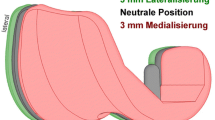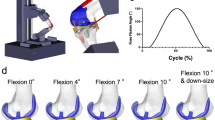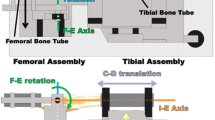Abstract
Purpose
Femoral component malrotation in total knee arthroplasty (TKA) is clinically proven to cause dissatisfaction and impaired function. This study is an attempt to characterize the tibiofemoral kinematics following femoral malrotation in posterior stabilized (PS) TKA. It was hypothesized that internal malrotation would introduce the most pronounced changes.
Methods
Six fresh-frozen cadaver specimens were mounted in a kinematic rig. Three motion patterns were applied with the native knee and following PS TKA (passive motion, open chain extension, and squatting) while infrared cameras recorded the trajectories of markers attached to femur and tibia. Three different femoral implants were tested: a conventional posterior stabilized component, and adapted components of the same implant with 5° of intrinsic external and internal rotation, respectively.
Results
The implantation of the PS TKA resulted in less tibial internal rotation (squat 33–70°, p < 0.05) and the medial femoral condyle shifted posteriorly especially in deep flexion (squat 84–111°, p < 0.05). Internal component malrotation caused internal rotation and abduction of the tibia in flexion (squat 33–111°, p < 0.05), an elevated (squat 43–111°, p < 0.05) and more anterior (passive 61–126°, p < 0.05) located medial femoral condyle and a lateral femoral condyle located more posterior and inferior (squat 73–111°, p < 0.05) than in the neutrally aligned TKA. External component malrotation caused only little changes under passive motion. Under a squat there was less internal rotation and more adduction to the tibia (33–111°, p < 0.05). The medial femoral condyle was moved more posterior (squat 59–97°, p < 0.05), the lateral femoral condyle more superior (squat 54–105°, p < 0.05) than in the neutrally aligned TKA.
Conclusion
The greatest differences to the native tibiofemoral kinematics were introduced by internal rotation of the femoral component. Also neutrally and externally rotated femoral components introduce kinematic changes, but to a lesser extent. With respect to the alterations introduced to kinematics internal malrotation should be avoided when performing PS TKA.





Similar content being viewed by others
References
Anouchi YS, Whiteside LA, Kaiser AD, Milliano MT (1993) The effects of axial rotational alignment of the femoral component on knee stability and patellar tracking in total knee arthroplasty demonstrated on autopsy specimens. Clin Orthop Relat Res 287:170–177
Anwar R, Kini SG, Sait S, Bruce WJ (2016) Early clinical and radiological results of total knee arthroplasty using patient-specific guides in obese patients. Arch Orthop Trauma Surg 136(2):265–270
Barrack RL, Schrader T, Bertot AJ, Wolfe MW, Myers L (2001) Component rotation and anterior knee pain after total knee arthroplasty. Clin Orthop Relat Res 392:46–55
Bedard M, Vince KG, Redfern J, Collen SR (2011) Internal rotation of the tibial component is frequent in stiff total knee arthroplasty. Clin Orthop Relat Res 469(8):2346–2355
Berger RA, Crossett LS, Jacobs JJ, Rubash HE (1998) Malrotation causing patellofemoral complications after total knee arthroplasty. Clin Orthop Relat Res 356:144–153
Chen Z, Wang L, Liu Y, He J, Lian Q, Li D, Jin Z (2015) Effect of component mal-rotation on knee loading in total knee arthroplasty using multi-body dynamics modeling under a simulated walking gait. J Orthop Res 33(9):1287–1296
Chew JT, Stewart NJ, Hanssen AD, Luo ZP, Rand JA, An KN (1997) Differences in patellar tracking and knee kinematics among three different total knee designs. Clin Orthop Relat Res 345:87–98
Dalury DF, Pomeroy DL, Gorab RS, Adams MJ (2013) Why are total knee arthroplasties being revised? J Arthroplast 28(8 Suppl):120–121
Duhamel A, Bourriez JL, Devos P, Krystkowiak P, Destee A, Derambure P, Defebvre L (2004) Statistical tools for clinical gait analysis. Gait Posture 20(2):204–212
Grood ES, Suntay WJ (1983) A joint coordinate system for the clinical description of three-dimensional motions: application to the knee. J Biomech Eng 105(2):136–144
Heyse TJ, El-Zayat BF, De Corte R, Chevalier Y, Scheys L, Innocenti B, Fuchs-Winkelmann S, Labey L (2014) UKA closely preserves natural knee kinematics in vitro. Knee Surg Sports Traumatol Arthrosc 22(8):1902–1910
Heyse TJ, El-Zayat BF, De Corte R, Scheys L, Chevalier Y, Fuchs-Winkelmann S, Labey L (2016) Balancing UKA: overstuffing leads to high medial collateral ligament strains. Knee Surg Sports Traumatol Arthrosc 24(10):3218–3228
Heyse TJ, Tibesku CO (2014) Improved femoral component rotation in TKA using patient-specific instrumentation. Knee 21(1):268–271
Heyse TJ, Tibesku CO (2015) Improved tibial component rotation in TKA using patient-specific instrumentation. Arch Orthop Trauma Surg 135(5):697–701
Insall JN, Scuderi GR, Komistek RD, Math K, Dennis DA, Anderson DT (2002) Correlation between condylar lift-off and femoral component alignment. Clin Orthop Relat Res (403):143–152
Kessler O, Lacatusu E, Sommers MB, Mayr E, Bottlang M (2006) Malrotation in total knee arthroplasty: effect on tibial cortex strain captured by laser-based strain acquisition. Clin Biomech (Bristol Avon) 21(6):603–609
Kessler O, Patil S, Colwell CW Jr, D’Lima DD (2008) The effect of femoral component malrotation on patellar biomechanics. J Biomech 41(16):3332–3339
Kuriyama S, Ishikawa M, Furu M, Ito H, Matsuda S (2014) Malrotated tibial component increases medial collateral ligament tension in total knee arthroplasty. Knee Surg Sports Traumatol Arthrosc 32(12):1658–1666
Lenhoff MW, Santner TJ, Otis JC, Peterson MG, Williams BJ, Backus SI (1999) Bootstrap prediction and confidence bands: a superior statistical method for analysis of gait data. Gait Posture 9(1):10–17
Mason JJ, Leszko F, Johnson T, Komistek RD (2008) Patellofemoral joint forces. J Biomech 41(11):2337–2348
Merican AM, Ghosh KM, Iranpour F, Deehan DJ, Amis AA (2011) The effect of femoral component rotation on the kinematics of the tibiofemoral and patellofemoral joints after total knee arthroplasty. Knee Surg Sports Traumatol Arthrosc 19(9):1479–1487
Murakami AM, Hash TW, Hepinstall MS, Lyman S, Nestor BJ, Potter HG (2012) MRI evaluation of rotational alignment and synovitis in patients with pain after total knee replacement. J Bone Joint Surg Br 94(9):1209–1215
Nagamine R, Whiteside LA, White SE, McCarthy DS (1994) Patellar tracking after total knee arthroplasty. The effect of tibial tray malrotation and articular surface configuration. Clin Orthop Relat Res 304:262–271
Peersman G, Taeymans K, Jans C, Vuylsteke P, Fennema P, Heyse T (2016) Malrotation deformities of the lower extremity and implications on total knee arthroplasty: a narrative review. Arch Orthop Trauma Surg 136(11):1491–1498
Sternheim A, Lochab J, Drexler M, Kuzyk P, Safir O, Gross A, Backstein D (2012) The benefit of revision knee arthroplasty for component malrotation after primary total knee replacement. Int Orthop 36(12):2473–2478
Stukenborg-Colsman C, Ostermeier S, Burmester O, Wirth CJ (2003) [Dynamic in vitro measurement of retropatellar pressure after knee arthroplasty]. Orthopade 32(4):319–322
Thompson JA, Hast MW, Granger JF, Piazza SJ, Siston RA (2011) Biomechanical effects of total knee arthroplasty component malrotation: a computational simulation. J Orthop Res 29(7):969–975
Vanbiervliet J, Bellemans J, Verlinden C, Luyckx JP, Labey L, Innocenti B, Vandenneucker H (2011) The influence of malrotation and femoral component material on patellofemoral wear during gait. J Bone Joint Surg Br 93(10):1348–1354
Verlinden C, Uvin P, Labey L, Luyckx JP, Bellemans J, Vandenneucker H (2010) The influence of malrotation of the femoral component in total knee replacement on the mechanics of patellofemoral contact during gait: an in vitro biomechanical study. J Bone Joint Surg Br 92(5):737–742
Victor J, Banks S, Bellemans J (2005) Kinematics of posterior cruciate ligament-retaining and -substituting total knee arthroplasty: a prospective randomised outcome study. J Bone Joint Surg Br 87(5):646–655
Victor J, Van Glabbeek F, Vander Sloten J, Parizel PM, Somville J, Bellemans J (2009) An experimental model for kinematic analysis of the knee. J Bone Joint Surg Am 91(Suppl 6):150–163
Author information
Authors and Affiliations
Corresponding author
Ethics declarations
Funding
The study was funded by Smith & Nephew.
Ethical standards
All performed procedures were done in accordance with the 1964 Declaration of Helsinki and its later amendments for comparable ethical standards. Knee specimens were obtained from Science Care, Phoenix, AZ, USA. Donors had dedicated their bodies to education and science during lifetime. Ethical committee approval was not obtained as it was not required for cadaver studies in Belgium by the time the study was performed.
Conflict of interest
TJH has been paid for presentations for Smith & Nephew, Zimmer Biomet and Implantcast. He has received research support from Smith & Nephew and Zimmer Biomet. He is a consultant to Smith & Nephew. RDC is an employee of Smith & Nephew. The other authors have nothing to disclose.
Rights and permissions
About this article
Cite this article
Heyse, T.J., El-Zayat, B.F., De Corte, R. et al. Internal femoral component malrotation in TKA significantly alters tibiofemoral kinematics. Knee Surg Sports Traumatol Arthrosc 26, 1767–1775 (2018). https://doi.org/10.1007/s00167-017-4778-1
Received:
Accepted:
Published:
Issue Date:
DOI: https://doi.org/10.1007/s00167-017-4778-1




